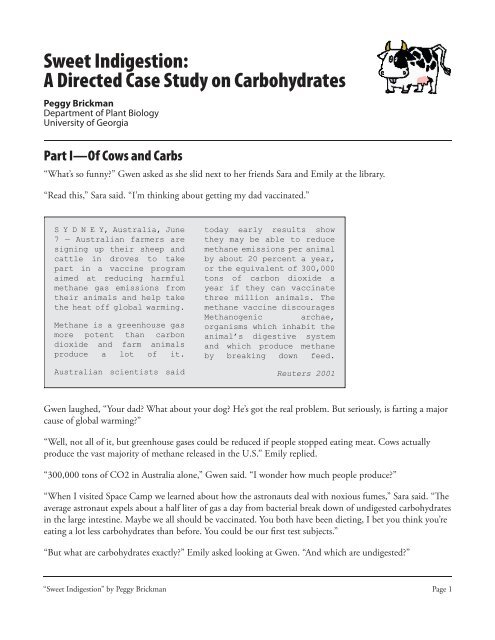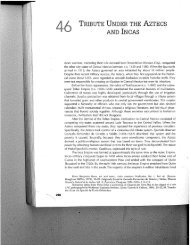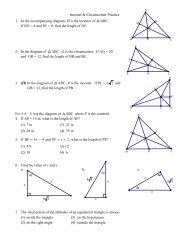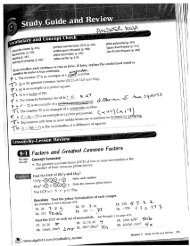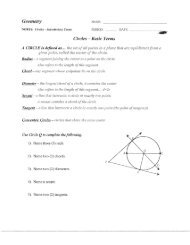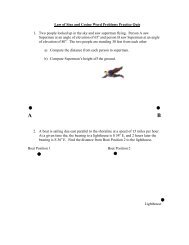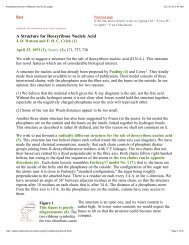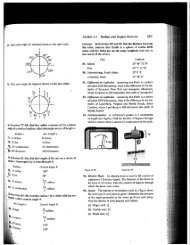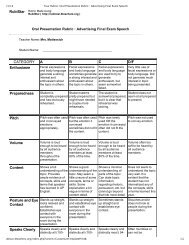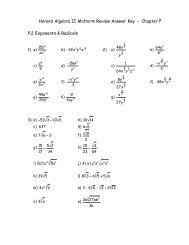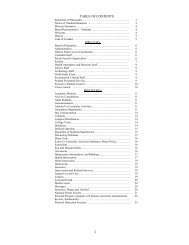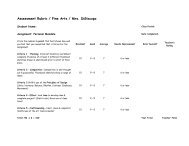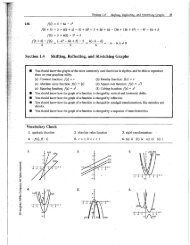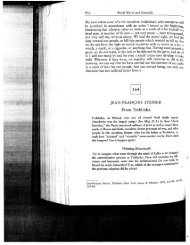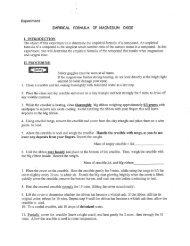Sweet Indigestion: A Directed Case Study on Carbohydrates
Sweet Indigestion: A Directed Case Study on Carbohydrates
Sweet Indigestion: A Directed Case Study on Carbohydrates
You also want an ePaper? Increase the reach of your titles
YUMPU automatically turns print PDFs into web optimized ePapers that Google loves.
<str<strong>on</strong>g>Sweet</str<strong>on</strong>g> <str<strong>on</strong>g>Indigesti<strong>on</strong></str<strong>on</strong>g>:<br />
A <str<strong>on</strong>g>Directed</str<strong>on</strong>g> <str<strong>on</strong>g>Case</str<strong>on</strong>g> <str<strong>on</strong>g>Study</str<strong>on</strong>g> <strong>on</strong> <strong>Carbohydrates</strong><br />
Peggy Brickman<br />
Department of Plant Biology<br />
University of Georgia<br />
Part I—Of Cows and Carbs<br />
“What’s so funny” Gwen asked as she slid next to her friends Sara and Emily at the library.<br />
“Read this,” Sara said. “I’m thinking about getting my dad vaccinated.”<br />
S Y D N E Y, Australia, June<br />
7 — Australian farmers are<br />
signing up their sheep and<br />
cattle in droves to take<br />
part in a vaccine program<br />
aimed at reducing harmful<br />
methane gas emissi<strong>on</strong>s from<br />
their animals and help take<br />
the heat off global warming.<br />
Methane is a greenhouse gas<br />
more potent than carb<strong>on</strong><br />
dioxide and farm animals<br />
produce a lot of it.<br />
Australian scientists said<br />
today early results show<br />
they may be able to reduce<br />
methane emissi<strong>on</strong>s per animal<br />
by about 20 percent a year,<br />
or the equivalent of 300,000<br />
t<strong>on</strong>s of carb<strong>on</strong> dioxide a<br />
year if they can vaccinate<br />
three milli<strong>on</strong> animals. The<br />
methane vaccine discourages<br />
Methanogenic archae,<br />
organisms which inhabit the<br />
animal’s digestive system<br />
and which produce methane<br />
by breaking down feed.<br />
Reuters 2001<br />
Gwen laughed, “Your dad What about your dog He’s got the real problem. But seriously, is farting a major<br />
cause of global warming”<br />
“Well, not all of it, but greenhouse gases could be reduced if people stopped eating meat. Cows actually<br />
produce the vast majority of methane released in the U.S.” Emily replied.<br />
“300,000 t<strong>on</strong>s of CO2 in Australia al<strong>on</strong>e,” Gwen said. “I w<strong>on</strong>der how much people produce”<br />
“When I visited Space Camp we learned about how the astr<strong>on</strong>auts deal with noxious fumes,” Sara said. “The<br />
average astr<strong>on</strong>aut expels about a half liter of gas a day from bacterial break down of undigested carbohydrates<br />
in the large intestine. Maybe we all should be vaccinated. You both have been dieting, I bet you think you’re<br />
eating a lot less carbohydrates than before. You could be our first test subjects.”<br />
“But what are carbohydrates exactly” Emily asked looking at Gwen. “And which are undigested”<br />
“<str<strong>on</strong>g>Sweet</str<strong>on</strong>g> <str<strong>on</strong>g>Indigesti<strong>on</strong></str<strong>on</strong>g>” by Peggy Brickman Page 1
Here’s a list of what the girls had eaten so far:<br />
• For breakfast—Cheerios with oat bran, a tall Latte with skim milk, and a PowerBar®.<br />
• For lunch—Coke and a salad with lettuce, cabbage, tomato, shredded carrot, green peas, kidney beans,<br />
and tuna fish.<br />
Questi<strong>on</strong>s<br />
1. Underline all foods c<strong>on</strong>taining carbohydrates.<br />
2. Come up with a rule to help you identify foods c<strong>on</strong>taining carbohydrates.<br />
3. How are carbohydrates made normally (i.e., what organism makes them)<br />
4. Which ingredient would cause gas Why are some foods digestible and others aren’t<br />
“<str<strong>on</strong>g>Sweet</str<strong>on</strong>g> <str<strong>on</strong>g>Indigesti<strong>on</strong></str<strong>on</strong>g>” by Peggy Brickman Page 2
Part II—Label Analysis<br />
The girls checked out a nutriti<strong>on</strong> textbook and learned that almost all of the foods they were eating<br />
c<strong>on</strong>tained carbohydrates. But how much gas is produced in your intestine depends <strong>on</strong> the type of bacteria<br />
you are harboring and whether or not you eat the following carbohydrates that aren’t well digested.<br />
Gwen’s list of carbohydrates that aren’t well digested:<br />
• Simple sugars:<br />
Dried beans, peas, and lentils c<strong>on</strong>taining the tri- and quatro-saccharides Raffinose and Stachyose<br />
Lactose<br />
Fructose<br />
Sorbitol, found in fruit but also an artificial sweetener<br />
• Starches<br />
• Insoluble fiber<br />
Analyze the PowerBar® food label below and then answer the questi<strong>on</strong>s that follow.<br />
INGREDIENTS: HIGH FRUCTOSE CORN SYRUP WITH GRAPE AND PEAR JUICE CONCENTRATE, OAT BRAN, MALTODEXTRIN,<br />
MILK PROTEIN ISOLATE, RICE CRISPS (MILLED RICE, RICE BRAN), PEANUT BUTTER (ROASTED PEANUTS, SALT), BROWN<br />
RICE, GLYCERIN<br />
©POWERBAR INC., BERKELEY, CA 94704 MADE IN USA ® REGISTERED TRADEMARK<br />
Nutriti<strong>on</strong> Facts<br />
Serving size 1 bar<br />
Calories 240<br />
Calories from Fat 30<br />
*Percent Daily Values (DV)<br />
are based <strong>on</strong> a 2,000<br />
calorie diet<br />
THE ORIGINAL PERFORMANCE ENERGY BAR TM<br />
Amount/Serving % DV Amount/Serving % DV<br />
Total Fat 3.5g 5% Total Carb 45g 15%<br />
Saturated Fat 0.5g 3% Dietary Fiber 3g 12%<br />
Cholesterol 0mg 0% Sugars 14g<br />
Sodium 120mg 5% Other Carb 28g<br />
Potassium 130mg 4% Protein 10g 20%<br />
Questi<strong>on</strong>s<br />
1. What percentage of the carbohydrates in the bar is simple sugar<br />
2. Can the girls omit all carbohydrates that are not well digested (like those in Gwen’s list) from their<br />
diet What are these carbohydrates used for<br />
3. What are the differences between simple sugars, starches, and fiber<br />
4. Use this PowerBar label to find all the ingredients that are carbohydrates of the following classes:<br />
Simple sugars<br />
Complex carbohydrates like starches<br />
Complex carbohydrates that c<strong>on</strong>tain fiber<br />
<strong>Carbohydrates</strong> that would produce gas according to the list<br />
Copyright © 2004 by the Nati<strong>on</strong>al Center for <str<strong>on</strong>g>Case</str<strong>on</strong>g> <str<strong>on</strong>g>Study</str<strong>on</strong>g> Teaching in Science.<br />
Originally published 10/13/04 at http://www.sciencecases.org/carbohydrates/carbohydrates.asp<br />
Please see our usage guidelines, which outline our policy c<strong>on</strong>cerning permissible reproducti<strong>on</strong> of this work.<br />
“<str<strong>on</strong>g>Sweet</str<strong>on</strong>g> <str<strong>on</strong>g>Indigesti<strong>on</strong></str<strong>on</strong>g>” by Peggy Brickman Page 3


